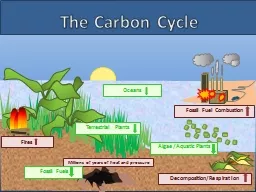

Oceans Millions of years of heat and pressure Fossil Fuel Combustion Algae Aquatic Plants Fires Fossil Fuels DecompositionRespiration Terrestrial Plants Algae Aquatic Plants Photosynthesis and Carbon Cycling ID: 913498
Download Presentation The PPT/PDF document "The Carbon Cycle Terrestrial Plants" is the property of its rightful owner. Permission is granted to download and print the materials on this web site for personal, non-commercial use only, and to display it on your personal computer provided you do not modify the materials and that you retain all copyright notices contained in the materials. By downloading content from our website, you accept the terms of this agreement.
Slide1
The Carbon Cycle
Terrestrial Plants
Oceans
Millions of years of heat and pressure
Fossil Fuel Combustion
Algae
/
Aquatic Plants
Fires
Fossil Fuels
Decomposition/Respiration
Slide2Terrestrial Plants
Algae
/
Aquatic Plants
Photosynthesis and Carbon Cycling
CO
2
CO
2
CO
2
CO
2
CO
2
CO
2
H
2
O
H
2
O
H
2
O
H
2
O
H
2
O
H
2
O
O
2
O
2
O
2
O
2
O
2
O
2
C
6
H
12
O
6
Photosynthetic plants and algae remove carbon dioxide from the air and combine it with water to build sugar molecules and oxygen molecules.
H
2
O
H
2
O
H
2
O
H
2
O
H
2
O
H
2
O
When organisms decompose, the reaction is reversed. Carbon dioxide is re-emitted into the air.
Decomposition/Respiration
CO
2
CO
2
CO
2
CO
2
CO
2
CO
2
In a natural system, growth and decomposition balance one another and the atmospheric carbon dioxide concentration remains fairly stable.
Slide3Terrestrial Plants
Algae
/
Aquatic Plants
CO
2
CO
2
CO
2
CO
2
CO
2
CO
2
H
2
O
H
2
O
H
2
O
H
2
O
H
2
O
H
2
O
O
2
O
2
O
2
O
2
O
2
O
2
C
6
H
12
O
6
H
2
O
H
2
O
H
2
O
H
2
O
H
2
O
H
2
O
Decaying Organic Matter
CO
2
CO
2
CO
2
CO
2
CO
2
CO
2
In a natural system, growth and decomposition balance one another and the atmospheric carbon dioxide concentration remains fairly stable.
Photosynthesis and Carbon Cycling
Decomposition/Respiration
Slide4Terrestrial Plants
Algae
/
Aquatic Plants
Fossil Fuel Combustion
Decomposition/Respiration
Fossil Fuels and Carbon Cycling
However, modern power stations, cars, and airplanes are releasing carbon that has been stored for millions of years in fossil fuel reserves. This disrupts the natural balance of the carbon cycle.
CO
2
CO
2
CO
2
CO
2
CO
2
CO
2
CO
2
CO
2
CO
2
CO
2
CO
2
Since the Industrial Revolution, the concentration of carbon dioxide has increased from 280 ppm (parts per million) to about 400 ppm.
Pre-Industrial
Modern
280 ppm
400 ppm
Slide5The Carbon Cycle: Overview
Terrestrial Plants
Oceans
Fossil Fuel Combustion
Algae
/
Aquatic Plants
Fires
Fossil Fuels
Decomposition/Respiration
Slide6Ocean Acidification
Sea Level RiseIncreasingly Severe Storms and DroughtsChanging Agricultural PatternsMigration of Tropical Diseases PolewardChanging Ocean Circulation PatternsClimate Change: Effects
Slide7The Carbon Cycle
Ocean Acidification
A
tmospheric carbon dioxide (CO
2 ) levels are rising because of fossil fuel combustion.
The
oceans uptake
much of this CO2 When the CO2 dissolves, carbonic acid is
formed
This acidification brings consequences for marine organisms and the system of which they are a part
Some organisms will be harmed; others may benefit
Slide8Case Study: Diatoms
Single-celled algae
Base
of the marine food webFix 20% of carbon globallyA portion of diatom remains sink and, over
millions of years, oil is formed from them How will increased dissolved carbon dioxide affect diatoms’ ability to fix carbon? What does this mean for climate change?
Thalassiosira pseudonana